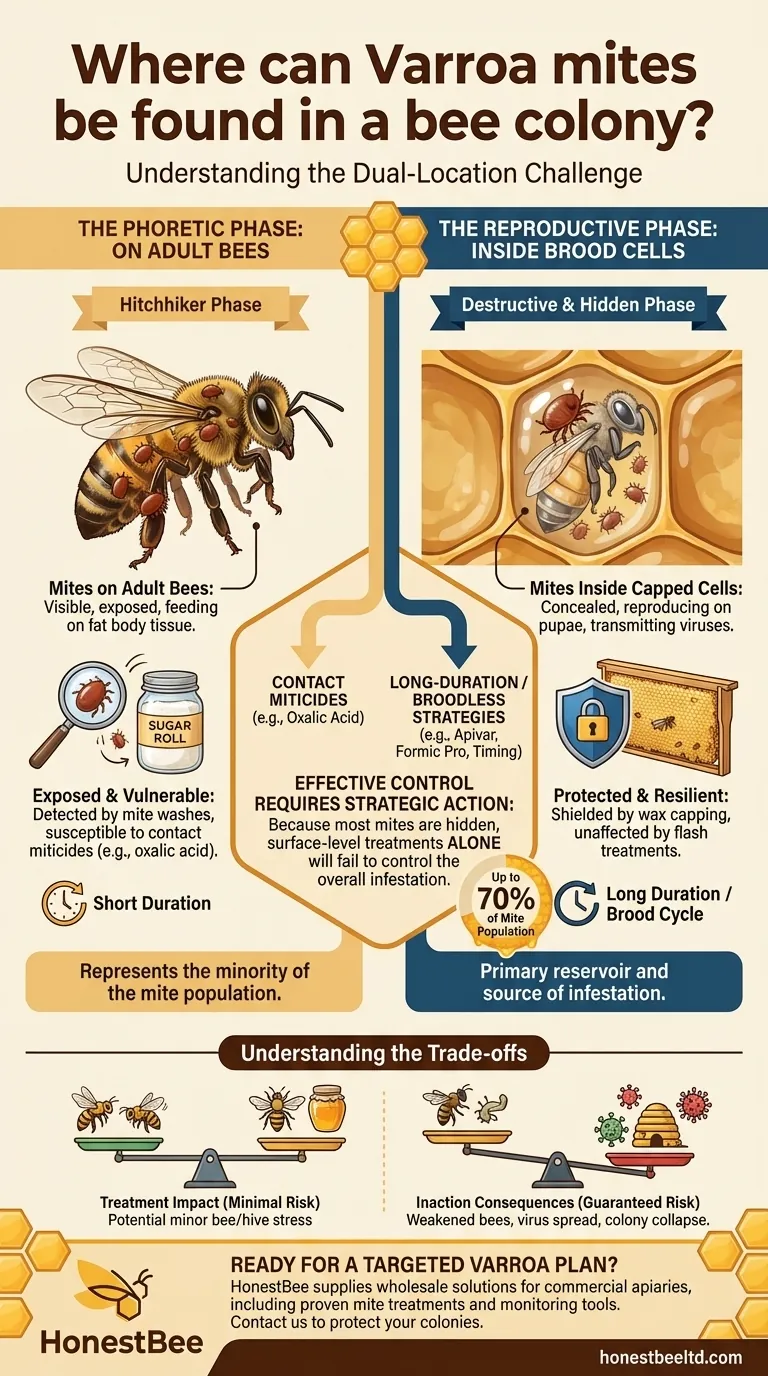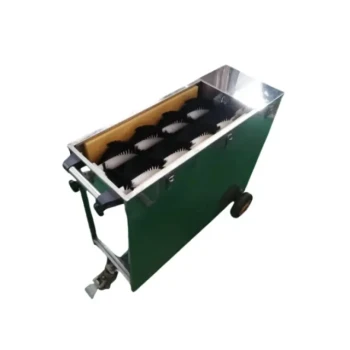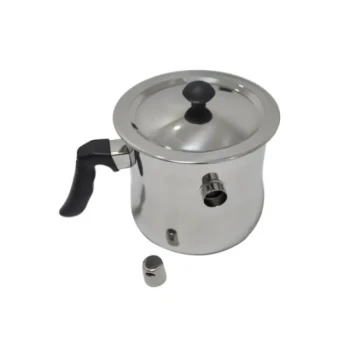In any given bee colony, Varroa mites are found in two primary locations: attached to the bodies of adult bees and hidden inside sealed brood cells. While mites on adult bees are more visible, they represent the minority. The vast majority of the mite population—often as high as 70%—is concealed within the capped cells, where they reproduce on developing bee pupae.
The core challenge of Varroa management stems from its dual-location nature. Because most mites are protected within capped brood at any given time, treatments that only affect adult bees will fail to control the overall infestation.

The Two Phases of a Varroa Infestation
To effectively manage Varroa, you must think of the infestation in two distinct parts. The location of the mite dictates its behavior, vulnerability, and the damage it causes.
The Phoretic Phase: On Adult Bees
This is the "hitchhiker" phase. During this time, mites cling to adult bees, primarily feeding on their fat body tissue, an organ crucial for the bee's immune function and metabolism.
Mites in the phoretic phase are exposed. They are the mites you count in a sugar roll or alcohol wash, and they are the ones vulnerable to contact-based miticides. However, they typically represent only a fraction of the total mite problem.
The Reproductive Phase: Inside Brood Cells
This is the most destructive phase and the key to the mite's success. A female mite will enter a worker or drone cell just before the bees cap it.
Safely sealed inside, she lays several eggs. The mother and her offspring feed on the developing bee pupa, weakening it and transmitting viruses. When the new bee emerges, it is often underweight and unhealthy, and several new mated female mites emerge with it to infest other bees. This hidden population is the colony's primary mite reservoir.
Why Mite Location Dictates Treatment Strategy
Understanding this population split is not just academic; it is the foundation of every successful Varroa management plan.
The Limitation of Surface-Level Action
Many treatments, particularly "flash" treatments like oxalic acid vaporization, are highly effective at killing phoretic mites on adult bees.
However, these methods cannot penetrate the wax cappings of brood cells. If a colony has a large amount of capped brood, a single flash treatment will leave the majority of the mite population completely untouched and ready to emerge.
The Importance of the Brood Cycle
Effective control requires a strategy that accounts for the reproductive mites. This can be achieved in two main ways.
First is by using long-duration treatments (like Apivar or Formic Pro) that remain in the hive long enough to kill mites as they emerge from cells. Second is by timing treatments for periods when the colony has little to no brood, such as in late fall, ensuring nearly all mites are in the vulnerable phoretic phase.
Understanding the Trade-offs
It is a difficult but essential truth that there is no perfect method for eliminating Varroa mites. Every available control comes with considerations.
The Reality of Bee Treatments
All current treatments, from "hard" chemicals to "soft" organic acids, have some potential impact on the bees, the comb, or the honey. These effects can range from minor bee stress to, if misapplied, significant queen or brood loss.
The goal of a beekeeper is not to find a treatment with zero impact, but to choose a tested, approved method and apply it correctly to minimize risk.
The Greater Risk of Inaction
The potential side effects of a correctly applied treatment are minimal compared to the guaranteed consequences of an unmanaged Varroa infestation.
High mite loads lead directly to weakened bees, the rapid spread of viruses like Deformed Wing Virus, and eventual colony collapse. For a modern beekeeper, the choice is not whether to treat, but how and when to do so effectively.
Making the Right Choice for Your Goal
Understanding where mites are located directly informs how you should monitor and treat them.
- If your primary focus is monitoring: Realize that a mite count from an alcohol or sugar wash only samples the phoretic population and must be used as an estimate for the much larger, hidden infestation.
- If your primary focus is treating during a major honey flow: Understand that with a large brood nest, your treatment must either last long enough to outlive a brood cycle or it will be largely ineffective.
- If your primary focus is a decisive "knock-down" of the mite population: Plan your most aggressive treatments for periods when the queen has stopped laying, ensuring nearly all mites are exposed on adult bees.
Effective Varroa control is not about a single action, but about strategically disrupting the mite's life cycle based on where they are at any given time.
Summary Table:
| Mite Location | Phase Name | Key Characteristics | Vulnerability |
|---|---|---|---|
| On Adult Bees | Phoretic | Hitchhiker phase; feeds on bee fat body; visible in mite counts | Vulnerable to contact miticides (e.g., oxalic acid) |
| Inside Brood Cells | Reproductive | Hidden phase; reproduces on pupae; transmits viruses; 70% of population | Protected by wax capping; requires long-duration treatments or broodless timing |
Ready to implement a targeted Varroa mite control plan for your apiary?
At HONESTBEE, we supply commercial apiaries and beekeeping equipment distributors with wholesale-focused solutions—including proven mite treatments and monitoring tools. Our experts can help you select the right products to tackle both phoretic and reproductive mites, protecting your colonies from devastating infestations.
Contact us today to discuss your specific needs and secure effective, reliable supplies for your operation.
Visual Guide

Related Products
- Adjustable Formic and Acetic Acid Dispenser for Bee Mite Treatment
- Varroa Easy Check Mite Tester Kit Counter Alcohol Wash Jar
- Economy Galvanized Beekeeping Honey Bee Smoker for Wholesale
- Professional Bee Smoker with Elongated Spout and Durable Bellows for Beekeeping
- Wooden Queen Bee Excluder for Beekeeping
People Also Ask
- What is the optimal time for varroa mite control in nucs? Maximize Efficacy with Perfect Timing
- What does Chewed Down Brood (CDB) indicate in bee colonies? A Sign of Varroa Mite Infestation
- What are the symptoms of Varroa Mite Syndrome (VMS)? Recognizing the Signs of Colony Collapse
- What should beekeepers do to manage varroa mites effectively? Adopt a Proactive Monitoring Strategy
- What are phoretic mites? A Beekeeper's Guide to Monitoring Varroa Infestation



















